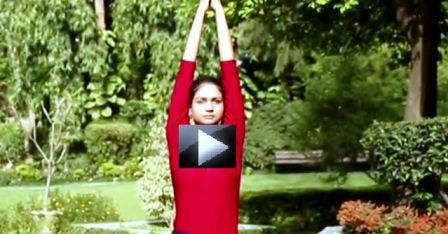Yogasanas
Yogasanas
- Standing Postures
- TaDaSaNa (Palm Tree Posture)
- Vrksasana (The Tree Posture)
- Pada-Hastasana (The Hands to Feet Posture)
- Arda C̣akrasana (The Half Wheel Posture)
- Trikonasana (The Triangle Posture)
- Sitting Postures
- Bhadrasana (The Firm/ Auspicious Posture)
- Vajrāsana (Thunderbolt Posture)
- Ardha Ustrasana (The Half Camel Posture)
- Ustrasana (Camel Posture)
- Sasankasana (The Hare Posture)
- Uttāna Mandūkāsana (Stretched up-frog posture)
- Vakrasana (The Spinal Twist Posture)
- Prone Postures
- Supine Postures
Standing Postures
TaDaSaNa (Palm Tree Posture)
Tada means palm tree or mountain. This asana teaches one to attain stability and firmness and forms the base for all the standing asana.
Technique
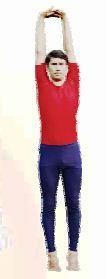 Stand with feet 2 inches apart.
Stand with feet 2 inches apart.- Interlock the fingers, and turn the wrist outwards. Now inhale, raise the arms up and bring them in line with the shoulders.
- Raise the heels off the floor and balance on the toes. Stay in this position for 10 -15 seconds.
- Exhale, bring the heels down.
- Release the interlock of the fingers and bring the arms down parallel to the trunk, and come back to standing posture.
Benefits
- This asana brings stability in the body, helps to clear up congestion of the spinal nerves, corrects faulty posture.
- Helps to increase height up to a certain age.
A word of caution
- Avoid lifting the toes in case of acute cardiac problems varicose veins and vertigo.
Vrksasana (The Tree Posture)
Vṛksa means tree.The final position of this asana resembles the shape of a tree, hence the name.
Technique
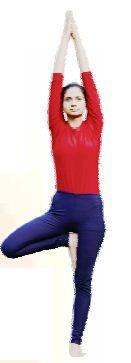 Stand with feet 2 inches apart
Stand with feet 2 inches apart- Focus on a point in front.
- Exhale, bend the right leg and place the foot on the inside of the left thigh. The heel should be touching the perineum.
- Inhale and extend the arms up and join the palms.
- Stay in the position for 10 to 30 seconds and breathe normally.
- Exhale and bring the arms and right foot down.
- Relax and repeat the asana by bending the left leg.
Benefits
- Improves neuro-muscular coordination, balance,endurance and alertness.
- It tones up the leg muscles and rejuvenates the ligaments also.
A word of caution
- Please avoid this practice in case of arthritis, vertigo and obesity.
Pada-Hastasana (The Hands to Feet Posture)
Pada means feet, hasta means hands. Therefore,Pada Hastasana means taking the palms down towards the feet. This is also referred as Uttanasana.
Technique
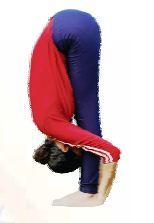
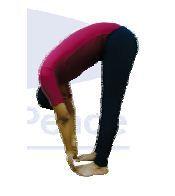 Stand with feet 2 inches apart
Stand with feet 2 inches apart- Inhale slowly and raise the arms up.
- Stretch up the body from the waist.
- Exhale and bend forward until the trunk is parallel to the ground.
- Exhale, and bend forward until the entire palm rests on the ground.
- Maintain this final posture for 10-30 seconds.
- Those who are having stiff back should bend according to their capacity.
- Now inhale, come up slowly to the vertical position and stretch the arms above the head.
- Exhale and slowly return to the starting position in reverse order.
- Relax in Tadasana.
Benefits
- Makes the spine flexible, improves digestions, and prevents constipation and menstrual problems.
A word of caution
- Please avoid this practice in case of cardiac or back problems, abdominal inflammation, hernia and ulcers,high myopia, vertigo and during pregnancy.
- Those with vertebral and disc disorders should also avoid this practice.
Arda C̣akrasana (The Half Wheel Posture)
Ardha means half. C̣akra means wheel. In this posture, as the body takes the shape of a half wheel, hence it is called Ardha C̣akrasasna.
Technique
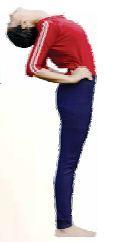 Support the back at the waist with all the fingers together pointing forward or downward.
Support the back at the waist with all the fingers together pointing forward or downward.- Drop the head backwards and stretching the neck muscles. As you inhale, bend backwards from the lumbar region; exhale and relax.
- Stay here for 10-30 seconds with normal breathing.
- Inhale and slowly come up.
Benefits
- Ardha C̣akrasana makes the spine flexible and strengthens the spinal nerves.
- Strengthens the neck muscles, and improves breathing capacity.
- Helps in cervical spondylitis.
A word of caution
- Avoid this posture in case of vertigo or a tendency to giddiness.
- Hypertensive patients shall bend with care.
Trikonasana (The Triangle Posture)
Trikoṇa means triangle. Tri means three and kona is an angle.As the asana resembles three arms triangles made by the trunk and the limbs, it has been named Trikoṇasana.
Technique
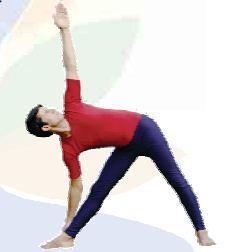 Stand with your feet comfortably apart.
Stand with your feet comfortably apart.- Slowly raise both the arms sideways till they are horizontal.
- Exhale, slowly bend to the right side and place the right hand just behind the right foot.
- The left arm is straight up, in line with the right arm.
- Turn the left palm forward.
- Turn your head and gaze at the tip of the left middle finger.
- Remain in the posture for 10-30 seconds with normal breathing.
- As you inhale slowly come up.
- Repeat for the left side.
Benefits
- Prevents flat foot.
- Strengthens calf, thigh and waist muscles
- Makes the spine flexible, improves lungs capacity.
A word of caution
- Avoid this posture in case of slipped disc, sciatica, and after undergoing abdominal surgery.
- Do not do beyond limits and overdo the lateral stretch.
- If one cannot touch the feet, one can reach for the knees instead.
Sitting Postures
Bhadrasana (The Firm/ Auspicious Posture)
Sthiti:Long sitting posture (Viṣramasana)
Technique
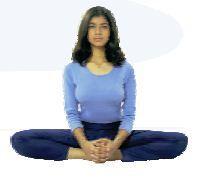
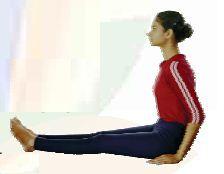 Sit erect with the legs stretched out straight in the front.
Sit erect with the legs stretched out straight in the front.- Keep the hands beside the hips. This is Dandasana.
- Now put the soles of your feet together.
- Exhale and clasp your hands together over your toes. Pull your heels as close as possible up to perineum region.
- If your thighs are not touching or are not close to the floor, place a soft cushion underneath the knees for support. This is the final position.
- Stay here for some time
Benefits
- Keeps the body firm and stabilize the mind.
- Keeps the knees and hip joints healthy.
- Helps to relieve knee pain.
- Acts on the abdominal organs and releases any tension in the abdomen.
- Benefits women by relieving abdominal pain often experienced during menstruation.
A word of caution
- Avoid this practice in case of severe arthritis and sciatica.
Vajrāsana (Thunderbolt Posture)
This can be considered as a meditative posture. While practicing it for meditative purposes, one should close his/her eyes at the final stage.
Technique
- Sit with extended legs together, hands by the side of the body, palm resting on the ground, fingers pointing forward.
- Fold the right leg at the knee and place the foot under the right buttock.
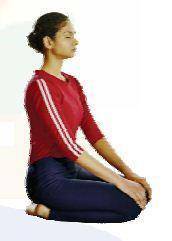
- Similarly folding the left leg, place left foot under the left buttock
- Place both the heels so that the big toes overlap each other.
- Position of the buttocks in the space between the heels
- Keep hands on respective knees.
- Keep the spine erect, gaze in front or close the eyes.
- While returning to the original position, bend a little towards right side, take out your left leg and extend it.
- Similarly extend your right leg and return to the original position.
Benefits
- This āsana strengthens thigh muscles and calf muscles.
- This āsana is good for digestion.
- It provides firm base to the spine and keeps the spine erect.
A word of caution
- Persons suffering from piles should not practise this āsana.
- Those who are suffering from knee pain and ankle injury should avoid this practice.
Ardha Ustrasana (The Half Camel Posture)
Sthiti:Long sitting posture (Viṣramasana)
Usṭra means camel. The final version of this āsana resembles the hump of a camel. In this version, only the first stage (half) of the āsana is being practiced.
Technique
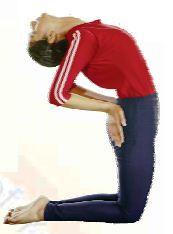 Sit in Viṣramasana.
Sit in Viṣramasana.- Come to Dandasana.
- Fold your legs and sit on your heels.
- Keep the thighs close and big toes touching.
- Place the hands on the knees.
- The head and back should be straight.
- This is Vajrasana
- Stand on your knees.
- Place the hands on the waist with fingers pointing downward.
- Keep the elbows and shoulders parallel.
- Bend the head back and stretch the neck muscles; inhale and bend the trunk backwards as much as possible. As you exhale, relax.
- Keep the thighs perpendicular to the ground
- Remain in the posture for 10-30 seconds with normal breathing.
- Return with inhalation; sit in Vajrasana.
- Relax in Viṣrāmāsana.
Note: If you can reach the heels, you can place your hands on them and bend backwards. This is called Uṣtrasana.
Benefits
- Relieves constipation and back pain.
- Increases blood circulation to the head and cardiac region.
A word of caution
- In case of hernia and abdominal injuries, arthritis, vertigo and pregnancy, please avoid doing this asana.
Ustrasana (Camel Posture)
Ustra means camel. The body in this posture resembles the posture of a camel, hence the name.
Technique
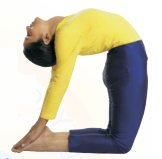 Kneel down on the floor. Keep your thighs and feet together, toes pointing back and resting on the floor.
Kneel down on the floor. Keep your thighs and feet together, toes pointing back and resting on the floor.- Bring the knees and the feet about one foot apart and stand on the knees.
- While inhaling bend backward.
- Be careful not to jerk the neck while bending backward.
- With exhalation place the right palm on right heel and left palm on left heel.
- In final position, thighs will be vertical to the floor and head tilted backwards.
- Weight of the body should be evenly supported by the arms and legs.
- This āsana should be practiced after Sarvagasana as a counter pose to enhance the benefits of Sarvangasana.
Benefits
- Ustrāsana is extremely useful for defective eyesight.
- This is useful in relieving back pain and neck pain.
- It helps to reduce fat over the abdomen and hips.
- It is helpful in digestive problems.
A word of caution
- Those suffering from high blood pressure, heart disease, hernia should not practice it.
Sasankasana (The Hare Posture)
Sthiti:Vajrasana
Technique
 Sit in Vajrasana.
Sit in Vajrasana.- Spread both the knees wide apart, keep the big toes touching.
- Keep the palms between the knees.
- Exhale and slowly stretch them full length.
- Bend forward and place the chin on the ground.
- Keep the arms parallel.
- Look in front and maintain the posture.
- Inhale and come up.
- Exhale and come back to Vajrasan.
- Stretch your legs back to Visramasan
Benefits
- It helps to reduce stress, anger etc
- It tones up reproductive organs, relieves constipation, improves digestion and relieves back pain.
A word of caution
- Please avoid this posture in case of acute backache.
- Patients with osteoarthritis of the knees should exercise with caution or avoid Vajrasana.
Uttāna Mandūkāsana (Stretched up-frog posture)
Uttāna mean upright and Mandūka means frog. The final position of Uttāna Mandukasana resembles an upright frog, hence the name. In Uttāna Mandūkāsana, the head is hold by the elbows.
Technique
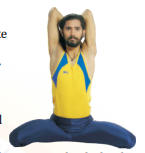 Sit in Vajrāsana
Sit in Vajrāsana- Spread both the knees wide, apart while toes remaining together.
- Raise your right arm, fold it and take it backward from above the right shoulder and place the palm below the left shoulder.
- Now fold left arm similarly and place the palm from the above level at below right shoulder.
- Maintain the position for a while, then coming back slowly to remove the left arm and then the right arm; bring the knees together as in the initial position.
Benefits
- This asana is helpful in backache and cervical pain.
- It helps in improving the diaphragmatic movements and helps to improve lungs capacity.
A word of caution
- Person with severe knee joint pain should not perform it.
Vakrasana (The Spinal Twist Posture)
Sthiti:Dandasana
Technique
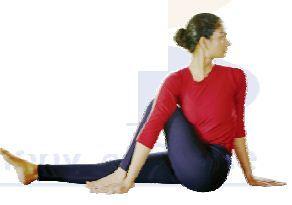 Bend the right leg, and place the right foot beside the left knee.
Bend the right leg, and place the right foot beside the left knee.- As you exhale, twist the body to the right.
- Bring the left arm around the right knee and clasp the right big toe or place the palm beside right foot.
- Take the right arm back and keep the palm on the ground with the back straight.
- Remain in the posture for 10-30 seconds with normal breathing and relax.
- Take out your hands with exhalation and relax
- Repeat the same on the other side.
- Inhale and come up.
Benefits
- Increases flexibility of the spine.
- Helps to overcome constipation, dyspepsia.
- Stimulates pancreas and helps in the management of diabetes.
A word of caution
- Please avoid this posture in case of severe back pain, vertebral and disc disorders, after abdominal surgery and during menstruation.
Prone Postures
Bhujangasana (The Cobra Posture)
Sthiti:Prone posture or Makarasana
Technique

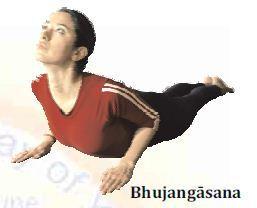 Lie down on your stomach, rest you head on your hands and relax the body.
Lie down on your stomach, rest you head on your hands and relax the body.- Now join your legs and stretch your arms
- Keep the forehead on the ground.
- Now place your hands just beside the body; keep palms and elbows on the ground.
- As you inhale slowly, lift the chin and chest come up to navel region.
- Stay there comfortably.
- This is called Sarala Bhujangasana.
- Now come back and place your forehead on the ground.
- Keep your palms besides the chest where your elbows were and raise the elbows.
- Inhale; slowly lift the chin and chest up to navel region.
- Exhale, rest your forehead on the ground and place your palms and rest your head on the palms and spread your legs and relax.
Note: Keep the legs firm so that no load or strain is felt on the lumbar spine.
Benefits
- This āsana is best for stress management.
- It reduces abdominal fat and alleviates constipation.
- It also helps to remove backache and bronchial problems.
A word of caution
- Those who have undergone abdominal surgery should avoid this asana for 2-3 months.
- Those who suffer from hernia, ulcers should not practice this asana.
Salabhasana(The Locust Posture)
Sthiti:Prone posture; Makarasana
Technique
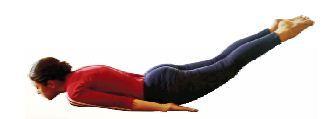 Lie down on your stomach in Makarasana.
Lie down on your stomach in Makarasana.- Rest the chin on the floor; keep both hands beside the body;palms facing upwards
- Inhale, raise the legs off the floor as much as you can without bending the knees.
- Extend the arms and legs well to ease the lift of the body off the floor.
- Stay in this position for 10-20 seconds breathing normally.
- Exhale, bring the legs down towards the floor.
- Rest for a few seconds in Makarasana.
Note: Pull up the knee caps and squeeze the buttocks to improve the posture. This āsana is more beneficial when performed after Bhujangasana
Benefits
- Helps in sciatica and lower backache.
- Tones the hip muscles and those in the kidney region.
- Reduces fat on the thighs and buttocks; good in weight management.
- Helps the abdominal organs aiding digestion
A word of caution
- Cardiac patients should avoid this posture. Please proceed cautiously in case of sever lower back pain.
- People with high blood pressure, peptic ulcers and hernia should also avoid this posture.
Makarasana (The Crocodile Posture)
In Sanskrit, Makara means crocodile. In this āsana, the body resembles a crocodile.
Sthiti:Prone relaxation posture
Technique
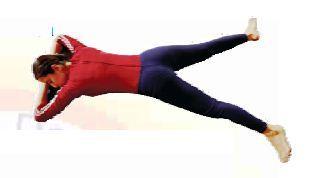 Lie down on your stomach with the feet wide apart, feet pointing outward.
Lie down on your stomach with the feet wide apart, feet pointing outward.- Bend both the arms and place the right hand on the left hand.
- Place the forehead on your hands.
- Keep the eyes closed. This is Makarasana.
- This asana is practiced for relaxation in all prone postures.
Benefits
- Promotes relaxation of the lower back.
- Helps in recovery of back problems.
- Indicated for all orthopedic ailments.
- Indicated to counter stress and anxiety.
A word of caution
- Avoid this practice in case of low blood pressure, severe cardiac problems and pregnancy.
Supine Postures
Setubandhasana (The Bridge Posture)
Setubandha means formation of bridge. In this posture, the body is positioned like a bridge, hence the name. This is also called as C̣atuṣpadasana.
Sthiti:Supine lying; Savasana.
Technique
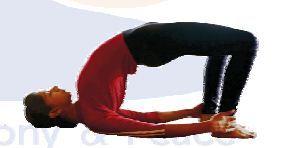 Bend both the legs at the knees and bring the heels near the buttocks.
Bend both the legs at the knees and bring the heels near the buttocks.- Hold both the ankles firmly; keep the knees and feet in one straight line.
- Inhale; slowly raise your buttocks and trunk up as much as you can to form bridge.
- Remain in this position for 10-30 seconds, with normal breathing.
- Exhale, slowly return to the original position and relax in Savasana.
Note: In the final position, the shoulders and head remain in contact with the floor and If required, in the final position, you can support your body at the waist with your hands.
Benefits
- Relieves depression and anxiety. Strengthens lower back muscles.
- Stretches abdominal organs, improves digestion and helps to relieve constipation.
A word of caution
- People suffering from ulcers and hernia, and women in advanced stages of pregnancy should not practice this asana.
Uttāna Pādāsana (Raised feet posture)
Uttāna in this context mean raised-upward and Pāda means leg. In this āsana, the legs are raised upward in supine position, hence, the name.
Technique
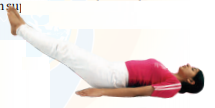 Lie comfortably on the ground with legs stretched out. Hands should be placed by the sides.
Lie comfortably on the ground with legs stretched out. Hands should be placed by the sides.- While inhaling, slowly raise both the legs without bending them at the knees and bring them to 300angle.
- Maintain the position with normal breathing.
- Exhale and slowly bring both the legs down and place them on the ground.
- Repeat it one more time.
Benefits
- It balances the navel centre (Nabhimanipuracakra)
- It is helpful in relieving abdominal pain, flatulence, indigestion and diarrhea.
- It builds up the abdominal muscles.
- It is also effective in overcoming the nervousness and anxiety.
- Helps to improve breathing and lungs capacity
A word of caution
- People with hypertension shall practice it with one leg alternatively without holding the breath.
Ardha Halāsana (Half plough posture)
‘Ardha’ means half and ‘Hala’ means plough. This posture is known as Ardha Halāsana because in its final position, the body resembles half the shape of an Indian plough.
Technique
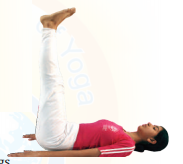 Take supine position; keep hands by the sides of thighs, palms resting on the ground.
Take supine position; keep hands by the sides of thighs, palms resting on the ground.- Slowly raise your legs together without bending at knees and stop at 300 angle.
- After few seconds raise your legs further up to 600 angle and maintain the position.
- Now slowly raise the legs at 900angle. This is the final position of the Ardha Halāsana.
- The body from hip to shoulder should be kept straight.
- Maintain this position as long as comfortable.
- Slowly legs at 900 angle and then on the ground without lifting the head.
Benefits
- This āsana is beneficial for dyspepsia and constipation
- The practice of this asana is useful in cases of diabetes, piles and throat related disorders.
- This is very beneficial for Hypertensive patients but needs to practice with care.
A word of caution
- Those who have lumbosacral (lower back) pain should not perform with both legs together.
- Avoid this practice in case of abdominal injuries, hernia etc.
Pavanmuktasana (The Wind Releasing Posture)
Pavan means wind and mukta means to release or to make free. As the name suggests, this asana is useful in removing wind or flatulence from the stomach and intestines.
Sthiti:Savasana
Technique
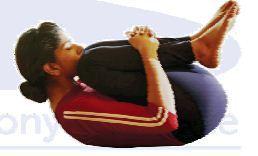 Lie down flat on the back.
Lie down flat on the back.- Bend both the knees and bring the thighs to the chest.
- Interlock the fingers and clasp the shin below knees.
- Exhale; rise the head till your chin touches the knees and relax.
- This is Pavanamuktasana.
- Bring the head back to the ground.
- While exhaling, lower the legs to the floor.
- Rest in Savasana
Note: Synchronise your breathing with the leg movement and While touching the knee with the nose/ forehead, you should be able to feel the lumbar region stretch; keep the eyes closed and focus your attention on the lumbar region.
Benefits
- Removes constipation; gives relief from flatulence, decreases the bloating sensation in the abdomen and aids digestion.
- Helps in recovery of back problems.
- Offers deep internal pressure, massage and stretching of the highly complicated network of muscles, ligaments and tendons in the pelvis and waist region.
- It tones up the back muscles and spinal nerves.
A word of caution
- Please avoid this practice in case of abdominal injuries, hernia, sciatica or severe back pain and during pregnancy.
Savasana (The Dead Body Posture)
Sava means dead body. The final position in this āsana resembles a dead body.
Sthiti:Supine Relaxation Posture
Technique
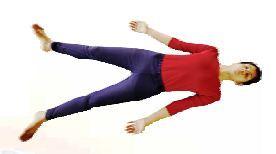 Lie down on your back with arms and legs comfortably apart.
Lie down on your back with arms and legs comfortably apart.- Palms facing upward; eyes closed.
- Relax the whole body consciously
- Become aware of natural breath and allow it to become rhythmic and slow.
- Remain in the position till you feel refresh and relax.
Benefits
- Helps to relieve all kinds of tensions and gives rest to both body and mind.
- Relaxes the whole psycho-physiological system.
- The mind, which is constantly attracted to the outer world, takes a U-turn and moves inwards, thus gradually getting absorbed; as the mind turns quiet and absorbed, the practitioner remains undisturbed by the external environment.
- It is found very beneficial in the management of stress and its consequences.
A word of caution
- Please avoid this practice in case of abdominal injuries, hernia, sciatica or severe back pain and during pregnancy.
Source: Ministry of AYUSH
Last Modified : 6/21/2022
This topic provides information about Internationa...
This topic gives complete Information related to D...
This topic provides information about Desktop Yoga...
This topic covers the Information related to Guide...
